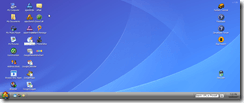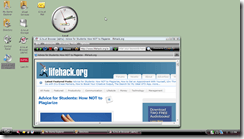In practice, it’s not quite so simple. Even making allowances for the varying states of development web desktops are in at the moment, none of them offer a compelling experience for web-based workers. I have looked at and played with almost two dozen of these applications, and so far haven’t found any that I could integrate very well into my daily routine. But there’s promise. Some of these apps are well worth watching, especially as they begin to interconnect with other services like Zoho Writer and Google Docs for document editing, Box.net’s OpenBox service for file storage, and other third-party services and plugins. I’ve highlighted three of the most promising webtop services below, followed by all the rest. The three most developed and usable web-based desktops are, in my humble estimation (and in alphabetical order): The rest of the list (also in alphabetical order) are services that, for one reason or another, don’t stand up to regular use. Some of them are incredibly slick, while others are absolutely bare-bones. Some are brand new projects, still in experimental, pre-Alpha state, others have been around for a while and are in full working order. Any one of them could suddenly take off with a sudden effort, so I’m not quite ready to count them out entirely; at the moment, though, none of them is in any state to do any serious work, no matter how “lickable”.
DesktopTwo: DesktopTwo is a Flash-based desktop with several productivity apps and a gorgeous, slick user interface. At least, that’s what I get from the screenshots — I was never able to log in. DesktopOnDemand: This might well be the service to beat, with 1GB storage in the free plan (with more costing 2p — about 4 cents — per GB per week), document and graphic editing (using GIMP, apparently), WebDAV support (meaning you can drag files on your desktop into your DOD folder and they are uploaded automatically), and more. Alas, they are not accepting new accounts at the moment, so I couldn’t log in and test it out. eyeOS: Slick and well-established, eyeOS has a very Mac-like feel. There is a word processor (and no other productivity apps) but it saves in .eyedoc format, which as far as I know only works in eyeOS. GCOE X: GCOE X focuses on cross-browser compatibility — it runs on Opera, Safari, even iPhones. At the moment, there is only a demonstration, with no applications or services. There’s very little information about what’s coming, but it’s one to keep an eye on. Glide: Another one focusing on cross-browser compatibility, especially smartphone browsers, Glide breaks the traditional desktop mold with its almost iPhone-esque interface — large glossy buttons fill its desktop offering access to apps, including a word processor, spreadsheet, and presentation app. Their GlideSync application can be downloaded to your desktop to synchronize files between Glide and your base PC, a nice touch. Glide also offers collaboration features — the free account allows up to 4 users and 2 GB of storage; paid accounts allow more users and more storage. Work in Glide can also be shared publicly with their “Publish” application. My big beef with Glide is that applications open in new tabs, which seems unnecessary. Goowy: Technically Goowy is not a web desktop but a web-based widget platform. It is quite stable and absolutely beautiful, the epitome of “lickable” interfaces. While none of the widgets do anything all that productive, it is easily imaginable that some savvy developer will put together a Google Docs or Zoho Widget, which would make it quite a compelling tool. Since Goowy widgets can run on your desktop, too, this could be an easy way to tie your local PC with your web-based experience. Jooce: Jooce is still in private beta, so I haven’t been able to play with it at all, but their screenshots look pretty cool. No indication of whether any serious productivity apps will be available or not. iCube Online Operating System: iCube mimics Windows almost exactly, down to the icons and menus. It offers a pretty full complement of applications (though no spreadsheet or presentation app), but I could only figure out how to save documents in the native “OOS Documents” format. MyGoya: MyGoya is based in Germany, which becomes apparent when you come across apps, menus, or help documents that haven’t been translated into English yet. It’s Flash-based interface is slick, though, whatever language it’s in. Their “ShareBase” allows you to set up sharing policies for collaboration, and they offer several ways to publish material — photos, blogs, documents — to the Web. Document creation and editing is handled by Zoho. though I couldn’t get it to create a new document to test. This is obviously a pretty big problem, but one I assume they’ll fix. The other issue I have is the stingy 512 MB storage — I know, it’s free, why should I complain, but free storage is becoming common — at least let us interface with other storage services if you don’t want, or can’t afford, the expense of supporting adequate storage locally. Mylgd: Perhaps the strangest of the online desktops, mylgd is an actual Gnome desktop, online. It’s in very early development — v0.1, they say — and there’s not much you can do with it, but imagine it down the road with OpenOffice and TuxRacer! Nivio: Nivio is another one that’s in private beta right now, so I haven’t played with it. This is a paid service, or at least it will be. But listen: it’s Windows XP, on the web. With MS Office, Adobe Reader, RealPlayer, and other familiar applications! Definitely one to watch. oDesktop: Yet another that’s “coming soon”, oDesktop will be hosted by you, on your domain, meaning you can use whatever storage your host or server has available. Not a free application, and no productivity apps, at least not in their current plans. Pytagor: I’m actually not sure what this does. It appears to be an online file manager; as far as I can tell, there are no applications at all, but you can store and share photos, RSS feeds, contacts, and documents. Everything you upload is indexed and searchable. Maybe out of place in this list, but where else would I put it? Schmedley: Schmedley does exactly the same thing as Goowy, and it’s every bit as much fun to say. Like Goowy, it’s not exactly a web desktop but rather is a platform for hosted widgets. But if I included Goowy, I had to include Schmedley, since they do exactly the same thing. Fair’s fair, after all. SSOE: Don’t let the “1.0a” designation fool you — the Flash-based SSOE is in very early development and doesn’t do anything at the moment. At the moment, you can choose to launch the “unstable version” or the “semi-stable version”. But I assume it is meant to do something, someday, and I do so love a good mystery… Xcerion: Hope you’re not getting tired of closed betas, because here’s another one. When it’s done, Xcerion promises a full-fledged web-based operating system, with access to hundreds of open source applications. We’ll have to wait and see on this one. Xindesk: This one isn’t a private beta, at least — it’s a private alpha. Again, it will be a Vista-like environment with tons of apps. When it gets here. YouOS: Finally, one you can use. YouOS got a lot of people really excited last year. It offers a bare-bones word processor and a browser that’s called “WhereWolf”, which is pretty cool. It hasn’t changed much in a long time, though — there’s not a whole lot you can do with it. But it’s stable — if they added some applications, it might well be one of the top contenders.
I’m sure I’ve missed a few, maybe even some really good ones, so let me (and our readers) know if there’s something that should be on this list. What I really want to know, though, is if anyone is actually using any of these services on a day-to-day basis, to do real work. What do you use, and for what? How is it working for you?



